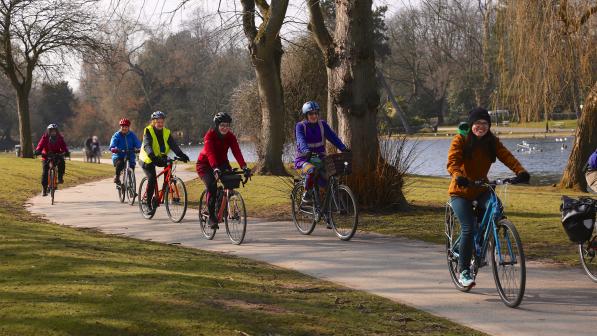Coronavirus: A guide to social distancing and cycling

In theory, public health guidance to stay at least two metres away from other people when out in public seems simple. However, whether you’re shopping for groceries at the supermarket or looking for somewhere to ride for your daily exercise, it’s sometimes a little tricky. We’ve received various questions about the best way to practice social distancing in different situations when out on your ride, so we’ve aimed to answer some of them here.
For other questions about cycling during Covid-19, check our coronavirus Q&A.
Why is keeping our distance important?
Government guidance is to stay at least two metres away from other people when you go outside.
GP and Cycling UK member Dr Kate Hattersley explains why:
“The Covid-19 infection is spread by droplets of fluid carrying the virus. If an infected person coughs or sneezes (even if they have no symptoms) the droplets can land on a hard surface and stay there for a while or land directly on another person. This is the reason why we should keep at least two metres away from others when we are outside our home.
“If we touch a surface contaminated by the virus then touch our face, we will infect ourselves. This is why it is important to wash our hands frequently and clean surfaces regularly.”
Recent research suggests that a greater distance may be needed when you are behind someone else, as droplets from coughs and sneezes can remain in the air behind someone who is moving. It’s important to note that this was a simulation and the paper hasn’t yet been peer-reviewed (verified by other scientists), but it might be something to bear in mind if you are approaching another cyclist or runner.
We all have a responsibility to ride carefully during this outbreak and maintain social distancing, to ensure we can continue to cycle.
Have a look at our extensive coronavirus Q&A for the latest cycling advice.
Shared-use paths and off-road trails
If you are going for a ride off-road, Cycling UK guidance is to plan your route to avoid parts you know are narrow and likely to be busy, and think about the time of day you pick for your ride.
On wide paths, it’s fairly easy to stick near the edges. If it’s less than two metres wide and you’re approaching people heading towards you, be prepared to stop and move over onto the verge to let them have enough space to pass.
Cycling UK training manager Matt Woodcock advises, “Give people as much room as possible when passing. Slow down and get into an easy gear to allow you to freewheel, and give them space. If you know your route you will know the pinch points, so you can try and anticipate where it is going to be difficult to pass.
“If you’re approaching someone from behind, let them know you’re there by calling out or using a bell if you have one, as they may not realise you’re about to pass them. Try and say hello and thank you to build good relations with other users – everyone appreciates a bit of extra friendliness at the moment.”
When overtaking walkers or slower-moving cyclists, try and move in a wide curve and avoid pulling back in quickly in front of them, so that you're not leaving them in your slipstream.
Canal towpaths
On canal towpaths, the same advice applies: drop your pace and leave as much space as you can, and be prepared to stop and wait for people approaching to walk past if you're coming up to a narrow stretch where there isn't space to pass safely.
Towpaths have the added difficulty of the lack of extra space at the edge. Cycling UK Head of Campaigns Duncan Dollimore says: “On narrow towpaths at busy times of the day, it’s likely that you will find it difficult to pass those on foot while leaving the recommended two metres of space. You’ll end up either riding at walking pace behind people or breaching the social distancing guidelines – so considering an alternative route or going at a quiet time of day become even more necessary.”
Take special care when going under bridges as the towpath is often narrow with reduced sight lines. It's also important to remember that many canal boats are also people's homes and their occupants may be trying to self-isolate, so they will want you to keep your distance and be considerate.

Shared-use footways
Many shared-use footways (which are often just pavements where cycling has been legally allowed) aren’t wide enough to leave two metres of space when passing people. There’s less traffic on some roads at the moment, so if you feel confident to do so, you might find it easier to ride on the road.
Alternatively, you can always get out the map, go online, or use an app to try and plan a quieter local route.
On roads
When riding on the road past someone who is walking along a narrow pavement, remember to still leave two metres of space.
Matt Woodcock explains, “If you are riding past someone walking on the pavement, check behind you and, if it’s safe to do so, pull out towards the centre of the road as if you were turning right. You can then move back in to the left once you have passed them.
“On narrow country lanes, if you meet people walking towards you along the road, if it’s safe to do so try and move right over to the other side in order to leave as much space as possible.”







